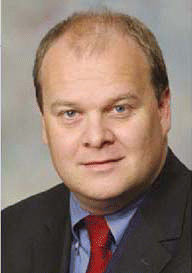Further research needs to be done about specific treatment modalities that could target biofilms in the sinuses, said Dr. Wang.
Explore This Issue
September 2006Additional studies also need to evaluate what makes the biofilm condition start and whether biofilms are the reservoir for superantigens and/or fungi, said Dr. Palmer.
Superantigens
A persistent bacterial infection may be a root cause of CRS, said Dr. Bernstein. He has been studying bacterial infections and the role of superantigens in the disease. Superantigens are defined as the exotoxins released by certain kinds of bacteria, including Staphylococcus aureus. Superantigens have special mechanisms that can upregulate lymphocytes, activating their Vbeta region, thereby producing TH1 and TH2 cytokines.
These cytokines bring inflammatory cells and eosinophils to the nasal mucosa, causing CRS. S. aureus is present in the mucin adjacent to nasal polyps in about 60% to 70% of cases of massive nasal polyposis.
Investigators have shown that superantigens are present in a certain percentage of patients, and that very severe patients produce IgE against these superantigens, which mediates to allergic rhinitis or allergy, but I have not seen any evidence that superantigens are stimulating the eosinophilic inflammation in CRS patients, said Dr. Ponikau. Superantigens might turn out to be an exacerbation factor-meaning that they fuel the fire-but so far much evidence is missing, he said.
These toxins released by S. aureus have been identified in CRS patients but further studies are needed to determine their role in the etiology of the disease, said Dr. Wang. Studies of CRS patients’ immune response to superantigens also need to be done, she said.
Other Causes
A number of other factors may contribute to CRS. For example, allergies to pollen or other types of aspirate may result in CRS, said Dr. Bernstein. Many people with nasal inhalant allergies don’t have CRS, noted Dr. Palmer. However, having allergy may lead to inflammation, he said.
Some patients have an allergy or sensitivity to aspirin, which results in the development of polyps and chronic sinusitis, said Dr. Wang.
I have not seen a single piece of evidence that the biofilm is actually causing the inflammation. – -Jens U. Ponikau, MD
Congenital anatomical abnormalities such as a deviated septum or a concha bullosa, which is an enlargement or ballooning of the nasal turbinate, can contribute to sinus obstruction and predispose patients to developing sinus complications including CRS, said Dr. Bernstein. Viral infection can also be a cause the disease, especially in people with a congenital abnormality that puts them at higher risk, he said.

Leave a Reply